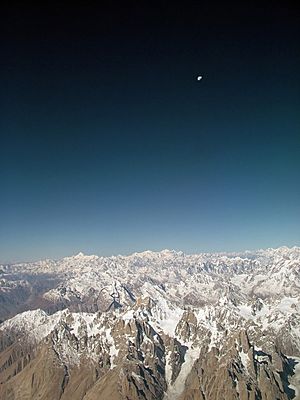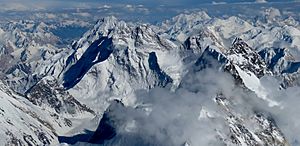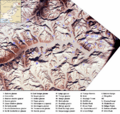Karakoram facts for kids
The Karakoram is a huge mountain range in Asia. Its name comes from a Turkic word meaning back gravel. This might refer to the rocky, broken-up land found there. You can find the Karakoram mainly in China, India, and Pakistan. Some parts also reach into Afghanistan and Kyrgyzstan. Many of its mountains are in areas like Gilgit-Baltistan, Ladakh, and Xinjiang.
The Karakoram is the second highest mountain range on Earth. It's part of a group of mountain ranges. This group also includes the famous Himalaya, Hindu Kush, and Pamir ranges. The Karakoram has eight mountains that are taller than 7,500 metres (24,600 ft). Four of these are even higher than 8,000 metres (26,000 ft)! These super tall peaks are K2, Gasherbrum I, Broad Peak, and Gasherbrum II. K2 is the second highest mountain in the whole world.
Contents
Exploring the Karakoram Mountains
This amazing mountain range is about 500 km (311 mi) long. It stretches across an area about 48 km (30 mi) wide. The Karakoram mountains act like a natural wall. They separate the region of Kashmir from China and other parts of South-central Asia. They also help protect Kashmir from the very cold winds that blow from Siberia.
There are over 300 mountain peaks in the Karakoram. Their heights range from about 1,480 metres (4,860 ft) to 8,611 metres (28,251 ft). That's a huge difference in height!
Glaciers of the Karakoram
The Karakoram is the most glaciated place in the world, outside of the polar regions. This means it has more glaciers than almost anywhere else. Glaciers are huge, slow-moving rivers of ice. They cover about 28% to 50% of the mountains here. This is much more than the Himalaya, where glaciers cover only about 8% to 12% of the mountains.
Some of the most famous glaciers in the Karakoram are the Siachen Glacier and the Biafo Glacier. The Siachen Glacier is 76 kilometres (47 mi) long. The Biafo Glacier is 63 kilometres (39 mi) long. These are the second and third longest glaciers in the world, not counting those in the North and South Poles.
Water Sources and Passes
Many hilly lakes and hot-water springs are also found in the Karakoram. The valleys in these mountains are the starting points for many rivers and streams. These waters eventually flow into the mighty Indus River.
The 5,540 metres (18,180 ft) high Karakoram Pass is a very important route. It connects Kashmir with the countries of Central Asia. People have used this pass for trade and travel for a very long time. Other important passes in this mountain range include Shaksgam Pass, Aghil Pass, and Khunjerab Pass.
Images for kids
-
The black gravel of Karakoram mountains, as seen near Pakistan's Biafo Glacier
-
Hunza Valley in the Gilgit-Baltistan region administered by Pakistan
-
Highest Karakoram peaks in the Baltoro region as seen from International Space Station
See also
 In Spanish: Cordillera del Karakórum para niños
In Spanish: Cordillera del Karakórum para niños







